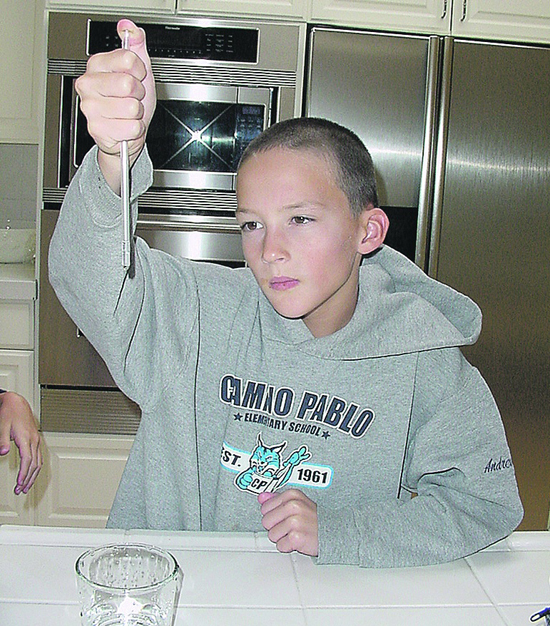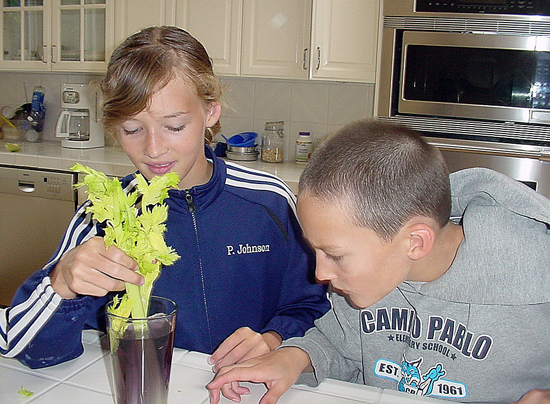| | Published August 18th, 2010
| Science in the Kitchen-Capillary Action
| | By Jonathan Winter |  | | Grant looks for the meniscus Photos provided
|
Water is sticky. Not as sticky as glue, but just a little sticky, like a weak magnet. It is this stickiness of water that makes most life on earth possible, as the following set of experiments will show.
 Experiment A
Experiment A
 1. Gather these supplies:
1. Gather these supplies:
 -A glass of water
-A glass of water
 -A penny
-A penny
 -A clear straw
-A clear straw
 2. Start your experiment:
2. Start your experiment:
 Dip the straw about 1 centimeter in the water and cover the top with your thumb so that a small amount of water stays in the straw when you lift it out. Release the water over the penny. Do this several times until the water forms a dome on the penny and can hold no more. Observe the penny from the side (at eye level to the table).
Dip the straw about 1 centimeter in the water and cover the top with your thumb so that a small amount of water stays in the straw when you lift it out. Release the water over the penny. Do this several times until the water forms a dome on the penny and can hold no more. Observe the penny from the side (at eye level to the table).
 3. What happened?
3. What happened?
 Water molecules are polar-that means they have different ends, like a magnet and those different ends attract each other like a magnet also. This is why water beads up and why raindrops are round. This stickiness of water (or any substance) to itself is called adhesion.
Water molecules are polar-that means they have different ends, like a magnet and those different ends attract each other like a magnet also. This is why water beads up and why raindrops are round. This stickiness of water (or any substance) to itself is called adhesion.
 Experiment B
Experiment B
 1. Gather these supplies:
1. Gather these supplies:
 -A glass of water
-A glass of water
 - A clear straw
- A clear straw
 (yes, you can use the same stuff from the last experiment!)
(yes, you can use the same stuff from the last experiment!)
 2. Start your experiment:
2. Start your experiment:
 Dip the straw in the water and cover with your thumb just as you did in experiment A. This time, hold the straw up to eye level and look at the water level in the straw. If you look closely, you will see the water forms a meniscus-a curved dish shape instead of being flat.
Dip the straw in the water and cover with your thumb just as you did in experiment A. This time, hold the straw up to eye level and look at the water level in the straw. If you look closely, you will see the water forms a meniscus-a curved dish shape instead of being flat.
 3. What happened?
3. What happened?
 The water doesn't just stick to itself, it also sticks to many other things. In this case, the water molecules on the side of the straw are attracted to the walls of the straw. The stickiness of water (or any substance) to something else is called cohesion. Adhesion and cohesion work together in the next experiment.
The water doesn't just stick to itself, it also sticks to many other things. In this case, the water molecules on the side of the straw are attracted to the walls of the straw. The stickiness of water (or any substance) to something else is called cohesion. Adhesion and cohesion work together in the next experiment.
 Experiment C
Experiment C
 1. Gather these supplies:
1. Gather these supplies:
 - A Glass of water
- A Glass of water
 - Dark food coloring (red, or blue)
- Dark food coloring (red, or blue)
 - Celery stalk with leafy end still attached
- Celery stalk with leafy end still attached
 2. Start your experiment:
2. Start your experiment:
 Put several drops of food coloring in the glass of water. Cut the base off of the celery and put the stalk in the water, with the leafy part at the top. Wait several hours or overnight. Observe the colored leaves at the top of your celery stalk.
Put several drops of food coloring in the glass of water. Cut the base off of the celery and put the stalk in the water, with the leafy part at the top. Wait several hours or overnight. Observe the colored leaves at the top of your celery stalk.
 3. What happened?
3. What happened?
 The celery is like a really narrow straw. It has tiny tubes that go up it, called capillaries. Water in these tubes sticks a little higher to the sides (remember the meniscus?). Other water molecules stick to the water that sticks to the sides. Then the water on the sides sticks a little higher again and the rest of the water sticks to it. In this way you can imagine the water "crawling) up the thin tube. This process "pulls" the water up the capillary, resisting the force of gravity pulling it down. This is how every plant, even the tallest trees, can get water into the uppermost branches and how blood (along with pressure from our hearts) moves through our bodies. It's amazing to imagine that the stickiness of water allows it to "climb!"
The celery is like a really narrow straw. It has tiny tubes that go up it, called capillaries. Water in these tubes sticks a little higher to the sides (remember the meniscus?). Other water molecules stick to the water that sticks to the sides. Then the water on the sides sticks a little higher again and the rest of the water sticks to it. In this way you can imagine the water "crawling) up the thin tube. This process "pulls" the water up the capillary, resisting the force of gravity pulling it down. This is how every plant, even the tallest trees, can get water into the uppermost branches and how blood (along with pressure from our hearts) moves through our bodies. It's amazing to imagine that the stickiness of water allows it to "climb!"

|
 | | Paige and Grant begin the celery experiment
| | | | | | | | | | | Advertisement | | |
| | | | | | Comments | | | | | |  | | |
| | |  | | |
| | | | |





